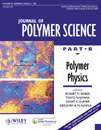Device model for poly(o-methoxyaniline) field-effect transistor
Abstract
We present a detailed study of the electric mechanism of a thin poly(o-methoxyaniline) (POMA) field-effect transistor. The device was prepared using Al-Si/SiO2/(interdigitated gold lines array)/POMA structure as the gate electrode, insulating layer, source-drain electrodes, and active layer, respectively. A model is presented for the electrical characteristics of such a device that encompasses the disordered properties of the POMA, the source-drain electrical-field dependence of hole mobility, and the carrier and mobility gradients in directions perpendicular to the polymer–oxide interface. The fittings of source-drain current versus source-drain voltage, having as parameters the gate voltage, is in good agreement with the experimental data, and the dependence of both the carrier saturation velocity and of the carrier mobility with the gate voltage are obtained. © 2004 Wiley Periodicals, Inc. J Polym Sci Part B: Polym Phys 43: 74–78, 2005




